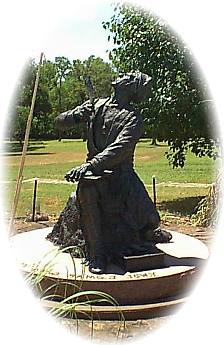Sequoyah County, OK
 In 1820, some of the Cherokee Indians migrated from Georgia and in 1838-39, the remainder of the tribe was forced-marched over the "Trail of Tears" to what is now Oklahoma. The southern-most land assigned to them is the present Sequoyah County area. When Oklahoma was granted statehood in 1907, the county was named Sequoyah in honor of the famous Cherokee educator.
In 1820, some of the Cherokee Indians migrated from Georgia and in 1838-39, the remainder of the tribe was forced-marched over the "Trail of Tears" to what is now Oklahoma. The southern-most land assigned to them is the present Sequoyah County area. When Oklahoma was granted statehood in 1907, the county was named Sequoyah in honor of the famous Cherokee educator.Sequoyah, the Cherokee soldier and teacher, gained world-wide fame when he devised the Cherokee syllabary. His statue is in the Nation's Capitol as one of Oklahoma's two greatest men. The giant redwood trees of California are named for him.
Sequoyah's original homesite is preserved in a beautiful park and historical complex just north of Sallisaw. Other artifacts of the area are on display in the 14 Flags Museum located in Sallisaw, as well as the restored depot and historic buildings around the town.
In western Sequoyah County just east of Gore, Tahlonteeskee, the first Cherokee capital, is reconstructed with the courthouse, council house, and Old Settler's Cabin.
The Robert S. Kerr Lake and Navagational System and Lake Tenkiller provide abundant outdoor recreation including boating, fishing, hunting, skiing, hiking, wildlife viewing, and educational opportunities at the Wildlife Refuge and the Lock and Dam.
Explore Sequoyah County
Sequoyah
Sequoyah was born in the lower Appalachian region of Tennessee about 1770. His mother was a member of the "Paint Clan" of the Cherokee Nation and his non-Indian father, Nathaniel Gist, left the family when Sequoyah was very young. Sequoyah grew to manhood among his kinsmen, the Cherokees.
Sallisaw, OK Famous PeopleSequoyah's Homesite
The original log cabin home of Sequoyah was built in 1829 and contains many artifacts relative to Sequoyah's remarkable achievements. Sequoyah built this one-room log cabin to serve as his home shortly after his move to what is present day Oklahoma.
Sallisaw, OK LandmarksSequoyah's Salt Works
Salt was a valuable commodity in the early 1800s. Besides being used as a seasoning, it was also used in food preparation and leather tanning. Salt also served as a medium of exchange in the West.
Sallisaw, OK Ethnic HeritageSequoyah County Historical Museum
Historical information throughout Sequoyah County.
Sallisaw, OK MuseumsSequoyah National Wildlife Refuge
Established to provide habitat for waterfowl and other migratory birds, the refuge lies at the junction of the Canadian and Arkansas Rivers and contains 20,800 acres, half of which is water.
Sallisaw, OK Wildlife RefugesSequoyah Statue
Sequoyah, the Cherokee soldier and teacher, gained world-wide fame when he devised the Cherokee syllabary. His statue is in the Nation's Capitol as one of Oklahoma's two greatest men. The giant redwood trees of California are named for him. The statue is located on the grounds of Sequoyah'
Sallisaw, OK ArtsWPA High School
This 1940 WPA High School is listed on the National Register of Historic Places. It is now used as a community center as a memorial to Argayle Quesenbery.
Sallisaw, OK Historic SchoolhousesShadow Creek Country Club
18 holes, bent grass greens, open to the public. South on Wheeler Street 1.5 miles, veer left at the curve and continue under the interstate.
Sallisaw, OK Golf CoursesMissouri-Pacific Depot/Library
The renovated Missouri-Pacific Railroad Station houses Sallisaw's public library, the Stanley Tubbs Memorial Library. The exterior of the building remains true to the original structure built over 75 years ago. Current fiction, non-fiction, children'
Sallisaw, OK Railroad HistoryOverstreet-Kerr Historical Farm
At the Overstreet-Kerr Farm visitors may glimpse life on this working farm as it was in the early 20th century. See the lavishly restored, 1895, antique filled, 14-room pioneer home that is listed on the National Registry of Historic Places
Sallisaw, OK Museums14 Flags Museum
14 Flags Museum is housed in the restored cabin, built in 1845, of Judge Franklin Faulkner, a pioneer lawyer of Sequoyah County. The museum contains early-day artifacts from this area. The entire museum complex includes a stretch of several log cabins with historical items on display.
Sallisaw, OK Museums